Understanding the Fraction of Four for Kids
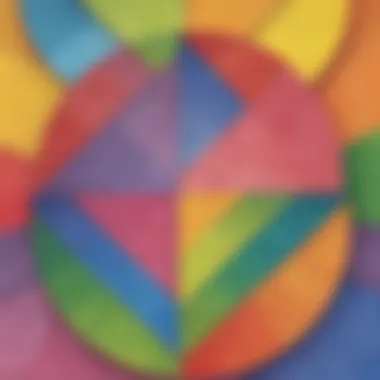
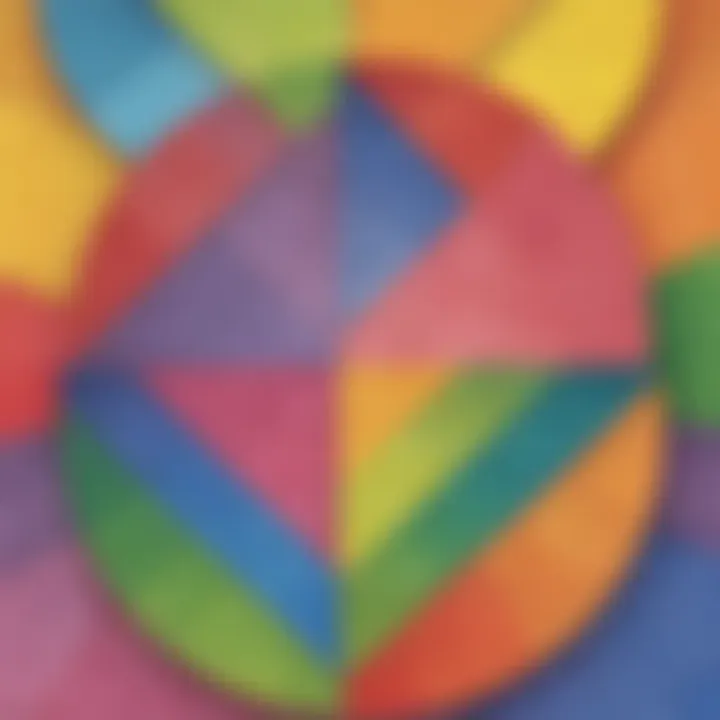
Intro
Understanding fractions can sometimes feel like trying to find a needle in a haystack, especially for young learners. But, fear not! This exploration takes a closer look at one fraction in particular: the fraction of four. Why four, you might wonder? Well, four is a common number in many aspects of life, making it perfect for illustrating how fractions work in a fun and relatable way.
In this article, we will unravel the basic principles of fractions, ensuring that learners grasp not only the concept but also see its relevance in their everyday experiences. We will dive into creative activities and quizzes, painting a clear and colorful picture of fractions for young minds.
So, whether you’re a teacher eager to spice up your lesson plans, a parent searching for resources, or a curious child ready to embark on this mathematical journey, let’s roll up our sleeves and dig into the engaging world of the fraction of four.
Prelude to Fractions
Fractions might seem like a tough nut to crack, especially for those just starting their math journey. But understanding them is more important than many realize. They are foundational in mathematics and sneak into many corners of our daily lives, often unnoticed. When kids learn about fractions, they unlock doors to comprehension not just in math but also in practical scenarios like cooking, dividing chores, or even sports. This section aims to lay down the groundwork for what fractions are and why they matter.
What Are Fractions?
At its core, a fraction represents a part of a whole. Think about a pizza, for example. If you have one whole pizza and decide to cut it into four equal slices, each slice is a fraction of that pizza. In this case, each slice is 1/4 of the whole pizza. The number on the top, called the numerator, tells us how many slices we have, while the number on the bottom, known as the denominator, tells us how many equal parts make up the whole. So, when you see 3/4, you understand you have three out of four equal parts, a simple way to express something that might initially seem complicated.
Importance of Learning Fractions
Learning fractions equips young minds with skills they will use throughout life. Here are a few key reasons:
- Real-Life Applications: From cooking to sharing toys, fractions are everywhere. Understanding them helps kids navigate daily tasks effectively.
- Problem-Solving Skills: Fractions force us to break down problems into smaller, manageable units. This skill is golden in academics and beyond.
- Mathematical Foundations: Fractions serve as building blocks for more complex ideas in math, like ratios and percentages. Mastering this concept early can smooth the path to future math topics.
In short, learning about fractions—especially fractions related to four—creates a strong foundation for advanced math concepts while simultaneously blending into the everyday fabric of life. It makes math relatable and useful, instilling confidence and competence in young learners.
Understanding the Number Four
Understanding the number four is essential when exploring fractions. This foundational number has various interactions in the world of mathematics. Grasping what four represents and how it functions can set young learners up for success in their future math endeavors. Moreover, recognizing the number four in different contexts reinforces the idea that math is not just numbers on a page, but rather an integral part of our day-to-day lives.
The Value of Four
The number four holds significant value in many aspects. For instance, it is the first composite number. This means that it can be divided into smaller whole numbers, which are 1, 2, and itself. This simple breakdown shows how four can be seen as more than just a numeral; it’s a building block for many mathematical operations.
When children learn about the value of four, they also discover that there are four corners in a square, four seasons in a year, and four cardinal directions. These concepts serve as a springboard to introduce the idea of dividing four into parts, hence moving into the realm of fractions.
To highlight its importance further, here’s a quick list of things associated with four:
- Four legs on a table provides stability.
- A rectangle has four sides, teaching geometry fundamentals.
- In music, a measure can have four beats, establishing rhythm in learning songs.
Four in Everyday Life
Four appears frequently in everyday life, making it a relatable topic for children. Think of games that require four players, such as soccer or basketball teams. Here, each member represents a part of the whole, making the concept of fractions tangible and meaningful.
Here are a few more examples where four creeps into our daily routines:
- Meals: Many dishes serve four portions, highlighting how food can be divided.
- Seating Arrangements: A typical dining table can often seat four people, which helps in visualizing groups and the division of space.
- Time: A quarter of an hour is a way to express 15 minutes, linking back to the fraction of four.
"Four is not just a number; it's a concept that translates into numerous aspects of our lives. When kids understand this, they begin to see math as a tool for understanding their world better."
This insight into the number four showcases its profound relevance. By learning about four and its various applications, young learners can better appreciate how fractions function within this context.
Breaking Down Fractions with Four
Breaking down fractions is not just about splitting numbers; it's about helping young learners grasp how parts fit into a whole. When we focus on four, we can illustrate vital math concepts in a way that sticks. Understanding fractions of four makes it easier for kids to relate to the math they encounter in their daily lives. Let's dive into the components that make this understanding crucial.
Identifying Parts of Four
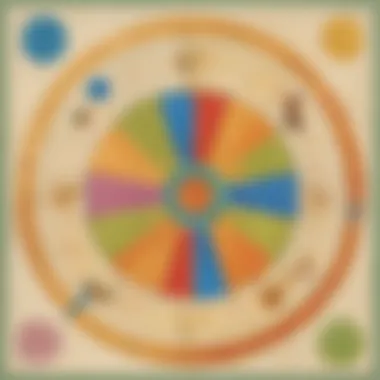

Fractions consist of two main parts: the numerator and the denominator. But here, we'll particularly zoom into how these parts relate to our favorite number, four. Understanding how numerators and denominators work with four sets the foundation for grasping fractions as a whole.
Understanding Numerators
The numerator is the number that sits on top of a fraction. It represents how many parts of the whole we are talking about. In a fraction like ( \frac34 ), the 3 is the numerator, meaning we are considering three parts of something that’s been divided into four. This is essential because it encourages children to think about not just what they see but what those numbers mean.
One key characteristic of numerators is their ability to express how much of the whole we are working with. It’s especially beneficial in simple examples; let’s say we have four apples, and we eat two. The fraction can be written as ( \frac24 ). It becomes easier for children to visualize and comprehend when they see real objects in action.
However, one disadvantage is that if students get too hung up on the numbers, they might miss the big picture of what the fraction represents. So, it’s crucial to integrate practical experiences alongside numerical examples.
Understanding Denominators
The denominator is the bottom part of a fraction, and it shows the total number of equal parts into which the whole is divided. When we say ( \frac24 ), the 4 tells us that our whole—whether it's a pizza or a group of apples—is divided into four equal parts.
The key takeaway here is that the denominator helps students understand division and equal parts. In our four example, the students learn that the apple, if divided among four friends, results in each friend receiving a quarter.
One drawback might be that younger children can find it hard to grasp the concept of equal parts. A hands-on approach can help; using pie charts can clarify how the denominator plays a role in understanding fractions.
Representing Fractions of Four
After identifying both numerators and denominators, the next logical step is to visualize those relationships. This leads us to different methods we can utilize to represent fractions of four effectively.
Visual Representation with Diagrams
Diagrams serve as invaluable tools in understanding fractions. They can turn abstract numbers into tangible visual elements. A diagram representing ( \frac24 ) can showcase a pie chart divided into four equal slices, with two slices colored in. This clear representation shows how fractions are portions of a whole.
A core characteristic here is how diagrams simplify complex concepts into digestible pieces for young minds. Children can look at a diagram and immediately grasp how much of the whole is being discussed, enabling quicker learning.
The downside could be that some students might rely too much on diagrams and struggle when translating back to numerical forms. So, it's essential to encourage a balance of both visual and numerical methods.
Using Objects for Better Understanding
Using objects makes number concepts real for kids. Imagine having four blocks. If we take away two, we can easily write ( \frac24 ). Seeing and touching those blocks helps solidify the idea that fractions are more than just numbers—they represent real quantities.
One aspect that makes this approach effective is the tactile experience. Kids learn better when they can interact rather than just see. However, if the objects are too small or uninteresting, they might lose focus and motivation. It’s vital to use appealing and relevant items during activities.
Tip: Always link fractions to tangible items to make learning more effective. Using actual things kids are familiar with helps them feel more connected to math.
In summary, breaking down fractions, especially focusing on four, brings clarity to the notions of numerators and denominators while providing effective visualization strategies. This structured approach lays a robust groundwork for young minds, guiding them toward more advanced mathematical comprehension.
Types of Fractions
Understanding different types of fractions is crucial in the journey of learning about mathematics, especially for young minds. Fractions are not just about simple addition or subtraction; they represent a world of quantities and relationships. The distinction between various types of fractions—specifically proper and improper fractions—clarifies their unique roles in arithmetic and everyday life. By exploring these two major types, learners foster deeper mathematical insight and develop critical thinking skills that they can apply in various contexts.
Proper Fractions
Definition and Examples
A proper fraction is when the numerator (the top number) is less than the denominator (the bottom number). This means it represents a quantity that is less than a whole. For instance, if you have three out of four pieces of chocolate, you'd say you have the fraction 3/4. This characteristic makes proper fractions popular in illustrating parts of a whole in a simple way.
The beauty of proper fractions lies in their straightforwardness. They are often easier for children to understand because they depict situations where something is shared among friends or divided into smaller parts. Consider this: if you were to split a pizza into four equal slices and eat two, you are left with the fraction 2/4, which can also be simplified to 1/2. This makes it clear how much pizza you have left and how much you enjoyed!
Activities to Understand Proper Fractions
Activities that engage children with proper fractions can make learning fun and interactive. One popular choice is using food items, like cutting fruits or pizzas into specific fractions. Young learners can actively participate by dividing apples into quarters or hamburgers into halves, giving them a tangible feel for fractions. Another option could be a coloring activity where children color specific sections of a shape to represent a proper fraction, such as coloring three out of four sections of a circle.
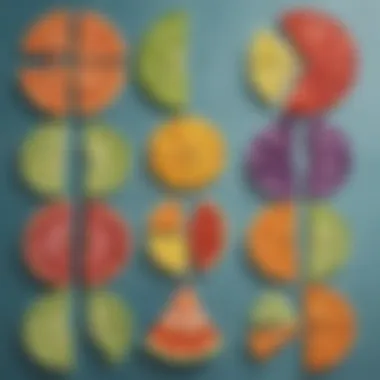
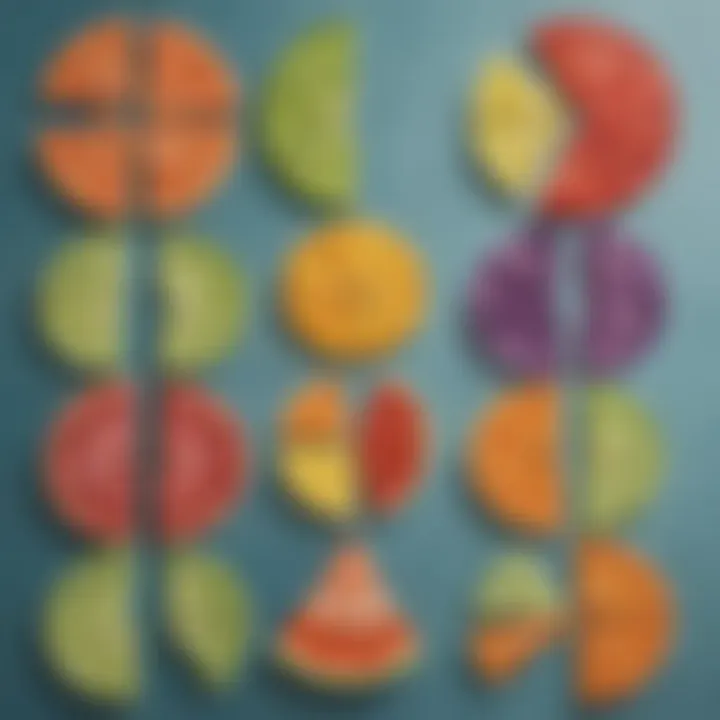
These hands-on experiences become memorable moments for children, allowing them to connect theoretical knowledge with real-life applications. The unique feature of these activities is that they transform abstract concepts into something they can taste and see. However, sometimes, these activities may create some mess, which could be a minor downside. Regardless, the advantages far outweigh any inconveniences, as children learn better through experience.
Improper Fractions
Definition and Examples
On the flip side, an improper fraction happens when the numerator is equal to or greater than the denominator. This category might seem confusing at first, but understanding it is just as important as grasping proper fractions. For example, if you have five slices of pizza, but the pizza is only in four slices (suggesting more pizza than what is available), it would be represented as 5/4. This fraction indicates that you have more than a whole, which can open discussions about how fractions can also signify excess.
The unique feature of improper fractions is their ability to represent quantities greater than one whole. This aspect not only expands students' understanding of quantity but it also deepens their grasp of division and scaling. Knowing about improper fractions helps young learners see that math isn’t always neatly cut; sometimes, things can overflow, much like filling a cup with water almost to the brim—it can’t hold more!
Activities to Explore Improper Fractions
To help kids grasp improper fractions, educators can employ various activities. For instance, they might utilize a classic game like the “Fraction Bingo” where improper fractions lead the way. This approach is successful since it makes learning enjoyable and competitive.
Another engaging activity could be using building blocks. Children can make towers that represent improper fractions, reinforcing the idea that those fractions indicate an excess of a portion. However, while these activities can be exciting, they sometimes pose a challenge for kids who are still getting to grips with basic fraction concepts, which can lead to frustration. Nonetheless, being aware of these fractions can empower learners to be more flexible in their problem-solving strategies.
"In learning math, understanding the types of fractions is like laying down the foundation for a big building. Without a strong foundation, the entire structure might crumble."
In summary, exploring proper and improper fractions is essential for young students' mathematical journeys. These types provide clarity on how fractions are part of our daily experiences, from dividing gifts to measuring ingredients in recipes. Understanding these concepts is not merely a matter of recognition; it's an invitation for learners to delve deeper into the fascinating world of mathematics.
Practical Scenarios Involving Four
Understanding how fractions of four play out in real-life situations can help students grasp the concept more effectively. This section looks at two everyday activities where the number four becomes relevant: cooking and games. By focusing on these practical examples, learners can appreciate not just the math involved, but also how it ties into their daily experiences. Plus, engaging with familiar scenarios helps solidify their understanding of fractions in a fun and relatable way.
Cooking and Baking
Cooking and baking are great examples of how fractions of four can be used in real life. Recipes typically require specific measurements, and knowing how to manipulate those amounts can make a dish turn out just right.
Using Four Cups
When a recipe calls for quantities, often it might say you need four cups of a specific ingredient, like flour or milk. This aspect plays a significant role in teaching children about measurement and the concept of fractions. Using four cups makes for a solid and simple number—kids can easily visualize it and understand how 1/4 cup fits into 4 cups.
One of the key characteristics of using four cups is its simplicity. Four is an easy number to divide, which makes calculations straightforward. For example, when kids grasp that half of four is two, they can apply this knowledge to scale recipes up or down.
However, challenges can arise if they mix up their measurements. If one forgets how many times they’ve poured 1/4 cup into the bowl, they could end up with a gooey mess instead of a lovely cake batter. Overall, using four cups provides a tangible and hands-on approach.
Dividing Ingredients into Fractions
Dividing ingredients into fractions is another fun and educational activity found in cooking. Here, for example, if a cake recipe requires dividing four cups of batter into different pans, kids can learn about fractions through action.
A highlight of this is that it allows children to see how fractions work in a practical scenario. When they take those 4 cups and split them into two halves, they can see that two cups are done for each pan.
This hands-on interaction emphasizes cooperation between math and culinary skills. But it's not all sunshine—if they don’t measure accurately, they might end up with uneven cakes. This can be a significant life lesson about precision in both cooking and math.
Games and Sports
Games and sports frequently employ the idea of groups or scoring using the number four, enhancing a child’s understanding of fractions while they have fun.
Teams of Four
Many sports are played in teams of four. Whether it's a relay race with four competitors or a small soccer match, recognizing these groups aids in understanding fractions through division. For instance, if there are eight players but only four can play at a time, students can easily calculate that half of the players are active.
The key characteristic here involves how well students relate to teamwork. It’s not only about learning fractions but also about working together towards a common goal. They quickly see that understanding fractions is crucial, as teamwork often relies on these skill sets.
However, it can also be tricky when there’s competition between groups. If they can’t balance their teams evenly, it might lead to some frustration in trying to figure out fair play. Still, active engagement in sports sensations reinforces mathematical concepts pleasantly.
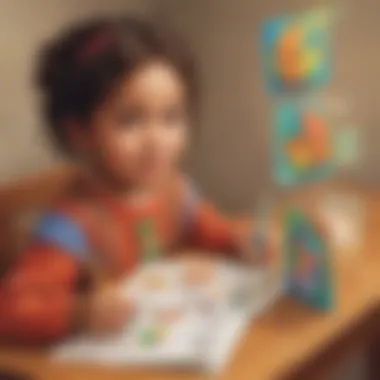
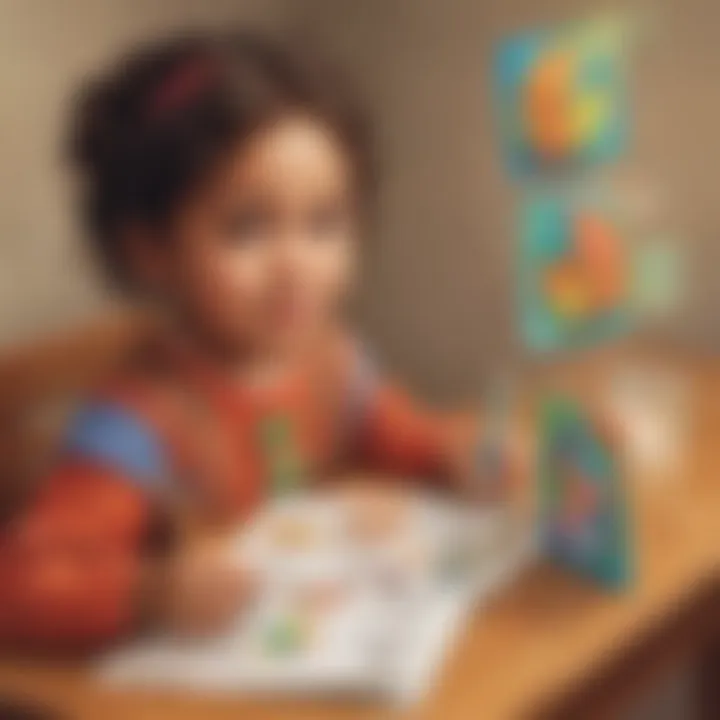
Scoring in Fractions
Scores in games often depend on fractions too. In basketball, for example, a team can earn three points for a basket shot from far away and only two points for closer shots. This opens doors for reflecting on fractions as they compare different scoring methods by using four-point, or two-point shots.
Being aware of scoring in fractions not only emphasizes numeracy but also teaches strategic thinking. Players might need to think whether it’s worth taking a risky three-point shot or playing it safe with a two.
When it comes to drawbacks, if players focus too heavily on fractions, they might miss enjoying the game itself, leading to missed shots and loss of interest. However, a balanced approach can help kids grasp the mathematical overlap with sports.
Understanding fractions through these practical scenarios makes learning enjoyable and relevant for young minds. It connects math to real life, promoting deeper learning.
Fun Activities for Learning Fractions
Learning fractions doesn’t have to be a dry and tedious task. Engaging young minds through enjoyable activities is a tried-and-true method of instilling concepts that might otherwise seem daunting. Fun activities are crucial for grasping fractions, especially in this exploration centered around the number four. They serve multiple purposes, from solidifying understanding to fostering a love for learning math.
Fraction Games
Interactive Online Games
Interactive online games offer a fresh and dynamic way to engage kids with the topic of fractions. Kids love technology, and when learning is blended with gaming, it becomes an exciting adventure. These games often incorporate colorful graphics and fun sounds, which can make understanding fractions feel like a breeze. They usually break down complex concepts into smaller, manageable tasks, providing instant feedback that lets students see their progress.
The key characteristic of these games is their interactivity. Players can manipulate fractions in a way that is stimulating. This participation helps reinforce learning without the pressure of a traditional quiz or test. One unique feature of interactive online games is how they often include challenges and rewards, making the process enjoyable and motivating. However, it's essential to balance screen time with other activities, so kids don’t get too carried away.
Hands-On Board Games
Hands-on board games bring a tangible element to fraction learning. These games often utilize physical pieces or cards that children can touch and manipulate. It’s a wonderful way to see fractions in action, literally! Board games can be played with family or friends, fostering social interaction. Playing games collaboratively allows learners to discuss their thought processes and strategies, which enhances their understanding.
A distinctive feature of hands-on board games is their ability to engage multiple senses. Engaging sight, touch, and even sound in some cases helps reinforce learning. While these games are fantastic, they require a bit of preparation and setup, which can be a disadvantage when compared to online alternatives. Nonetheless, the laughter and interaction that come from board game nights can create lasting memories, making such games well worth the investment.
Craft Projects
Creating Fraction Flags
Craft projects like creating fraction flags encourage creativity while subtly teaching mathematical concepts. By designing flags that represent different fractions of four, children visualize the idea of fractions in a creative and exciting way. Each flag can showcase various divisions, like one-fourth, two-fourths, or three-fourths, which helps solidify the concept clearly.
The beauty of this project lies in its customizability. Children can pick colors, shapes, and decorations to express themselves. It’s not just about learning; it becomes a personal endeavor for them. One potential drawback is the need for materials and space, but many kids enjoy getting hands-on with glue, scissors, and paper.
Building Fraction Pizzas
Building fraction pizzas is another fun craft idea that combines math and cooking. Using paper plates or cardboard, kids can create pizzas divided into different fractions. For example, they could cut one pizza into four slices and color one slice red to show one-fourth. This activity clearly illustrates how fractions work in a fun, relatable way that they can connect to real life.
The key feature of this project is that it connects food with learning, making the whole experience mouth-watering. Kids often love pizza, so it keeps their interest high. Although it’s a bit messy and requires cleanup afterward, these drawbacks often go unnoticed with the laughter and joy shared during the activity.
The key to understanding fractions lies in the practice and engagement that comes from fun activities. Learning should feel playful, not burdensome.
End
In our exploration of fractions, particularly focusing on four, we’ve traveled a wonderful path of understanding and discovery. Fractions are not just mathematical symbols; they are essential tools for interpreting and interacting with the world around us.
Recap of Fractions of Four
To recap, we learned that the fraction of four serves as an incredible bridge to grasping the broader concept of fractions. We broke down how understanding the numerator and denominator allows us to express how parts relate to a whole. For instance, if we have four apples and we take two, that represents the fraction 2/4 or one-half of the four apples. This simple yet effective way of thinking helps young minds visualize fractions in their daily lives.
"Understanding fractions can be like unlocking a door to a new way of seeing numbers. It's not just about slices of pizza or pieces of cake, but a deeper connection with math in every day life."
This understanding will set the stage for more complex ideas in mathematics. By practicing with real-life applications, such as cooking or playing games, children can see the relevance of what they’ve learned. The more they interact with fractions, the more natural it will become.
Encouragement to Explore More
Moreover, encouraging exploration beyond this foundational knowledge is paramount. Mathematics is vast and varied, and the fraction of four can serve as a stepping stone to more advanced mathematical concepts. Young learners should be motivated to ask questions, whether it’s about converting fractions to decimals, or understanding mixed numbers.
- Visit interactive websites to play math games that strengthen these concepts.
- Engage in activities that encourage hands-on learning, such as measuring ingredients while cooking.
There’s a big world of math waiting to be discovered, filled with exciting challenges and engaging problems. Armed with the basics about fractions, particularly those involving four, children are well on their way to becoming confident and capable math thinkers. So, let curiosity be your compass, and keep exploring the wonderfully intriguing world of mathematics!







